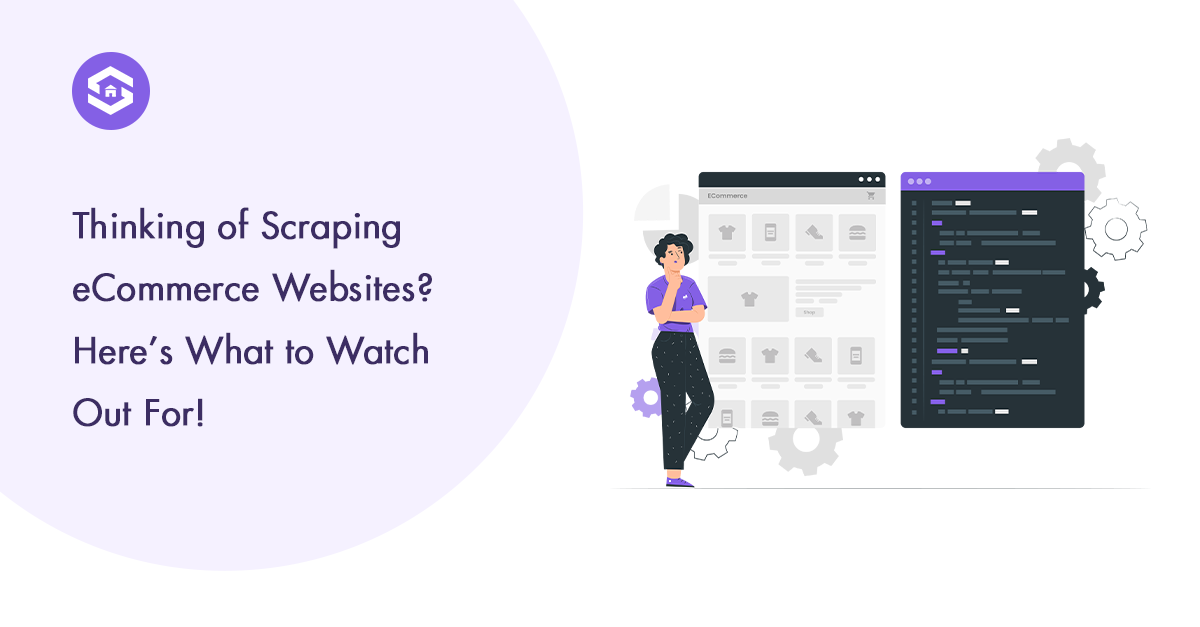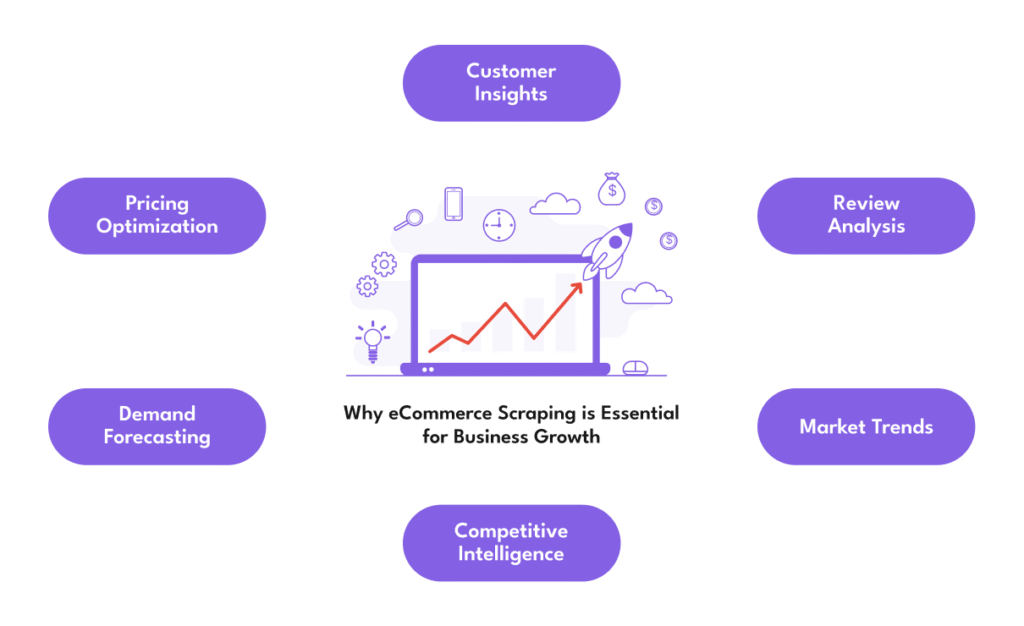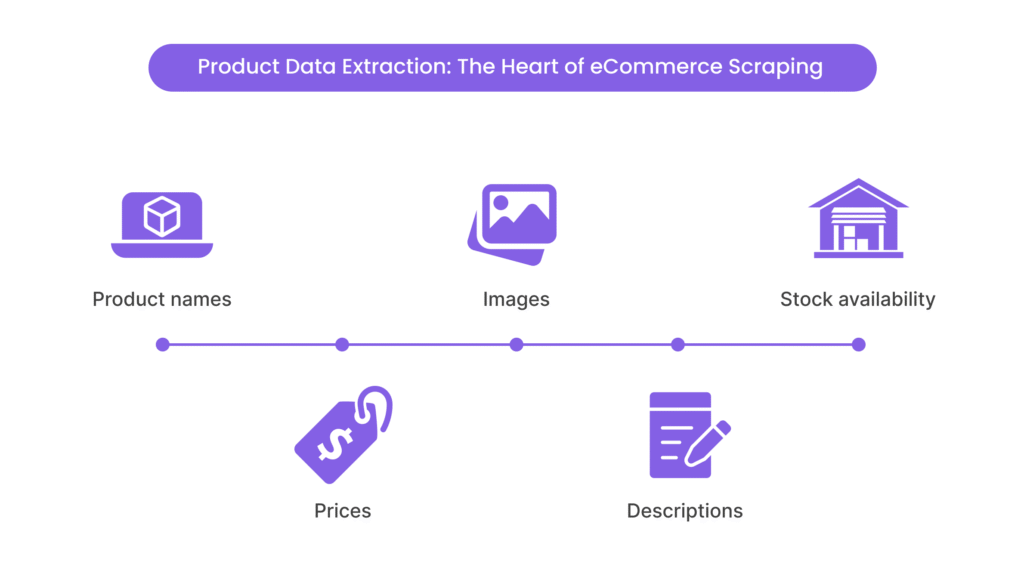Thinking of Scraping eCommerce Websites? Read This First!
8 min read
8 min read

Table of Contents
Table of Contents
In eCommerce, data is everything. Whether it’s product info, customer reviews, or competitor pricing, staying on top of this data is the important thing to getting ahead. But let’s be real—collecting all of it manually? That’s a never-ending task, and errors are bound to appear. So, what’s the smarter way to do it? Scrape eCommerce Websites to gather the data you want speedily and accurately—without wasting hours digging through endless pages!
That’s where eCommerce data scraping comes in. Have you ever been curious about how you may scrape online stores for data quickly, correctly, and accurately? You’re in the right place! In this article, I will take you through the whole lot you’d love to know about scraping eCommerce websites—from pulling product information to competitor price tracking. Are you ready? Let’s begin!
The global eCommerce market is predicted to reach $7.4 trillion by 2025, and businesses employing data extraction will have a good competitive edge. But how much does web scraping help to advance business?

Without eCommerce data scraping, businesses would struggle to get large-scale insights, making it impossible to respond to market changes efficiently.
So, what exactly is eCommerce data scraping? Simply described, it is the automatic extraction of essential information from online retailers. This could include everything from product descriptions and pricing to customer reviews and availability. The purpose is to make data collection quicker, more accurate, and less labour-intensive. Businesses that scrape eCommerce websites can gain real-time insights into competitor strategies, market trends, and consumer behavior without manual effort.
Consider growing a business that sells the same items as Amazon or eBay, but manually adjusts the price every few hours. This is not the simplest waste, but also time-consuming. Web scraping lets you automate this process, amassing data from many websites and structures without breaking a sweat.
When you think of eCommerce data scraping, product data extraction is one of the first things that comes to mind. It is the process of extracting information from product pages such as:

When scraping product data, make sure it’s far-based and tidy so it can be without difficulty integrated into your system. This may be done through dependent data extraction, which structures the information in a way that makes it clear to process and analyse.
Amazon and eBay are eCommerce giants that provide a ton of valuable data. Scraping Amazon and eBay isn’t just about collecting information on product listings; it’s approximately staying ahead of the curve.
For example, imagine you’re a retailer. By scraping Amazon’s pricing data, you could adjust your own prices to stay competitive. You can also track the number of products in inventory, what your competitors’ exceptional dealers are, or even how customers are reviewing products.
It’s not just about price, even though. By collecting data from customer reviews on Amazon or eBay, you can gain insights into client preferences, satisfaction levels, and capacity gaps within the marketplace. This makes scraping those structures incredibly valuable.
One of the most important applications for e-commerce scraping is competitive price monitoring. In the fast-phase global of online retail, price is regularly one of the maximum important factors affecting a customer’s buying decision. Scraping competitor websites for pricing data helps you stay competitive, adjust your pricing strategies, and maximize your market success.
By scraping competitor prices regularly, you can:
Automating this process with web scraping saves hours of manual effort and keeps your pricing consistently competitive.
With any type of data collection, there are best efforts that you need to make sure that your ecommerce information scraping efforts are effective, ethical and legal. Some of the greatest methods should not be forgotten here:
Respect Robots.txt: Every website has a robots.txt file that provides guidelines on what pages can and cannot be scraped. Always check and respect these guidelines.
Use Proxies and IP Rotation: Scraping large volumes of data from a single website can trigger anti-scraping mechanisms. Using proxies or rotating IP addresses helps avoid getting blocked.
Set Rate Limits: To prevent overwhelming a website’s server, ensure that your scraping tool has rate limits in place to control how quickly data is collected.
Be Mindful of Legal Issues: Scraping can be a grey area legally, especially when dealing with copyrighted content or violating terms of service. Always ensure you’re complying with local laws and website terms.
By following these best practices, you can ensure that your eCommerce data scraping is efficient, respectful, and sustainable.
One of the most essential advantages of automated web scraping is that it gets rid of the need for guide intervention. Once installed, automated scraping tools can constantly pull data from websites, saving you effort and time. You can set it and overlook approximately it, knowing that your information might be gathered on a regular schedule.
Some key benefits of automated web scraping include:
By automating the process, you can collect huge volumes of data quickly and accurately.
To be successful in eCommerce data scraping, understanding the different data extraction techniques is crucial. Several methods can be used to extract data from online stores, including:

While several of these strategies can be effective, based on data extraction is frequently the most efficient way to acquire clean and usable data. By specialising in scraping data in a standard format (e.g., JSON, CSV, or XML), businesses can ensure that data is easily integrated into their existing systems and workflows.
The selection of the right tool for ecommerce data scraping is necessary to achieve efficient and accurate results. Many scraping tools are available, providing different features. To scrape eCommerce websites effectively, here are some factors to consider when choosing tools:
By carefully assessing your requirements and selecting the right tool, you can effectively streamline your eCommerce data scraping operations and extract useful insights.
Scraping ecommerce websites offers businesses several options to gain a competitive advantage. Understanding the fundamentals of web scraping for online stores and learning key data extraction techniques is essential. With the right approach, you can effectively display product data, monitor competitive prices, and track other important metrics. If you operate web scraping to take away Amazon, eBay, or other online stores’ data, the insights you gain from this information would possibly assist you tailor your company plan and live aggressively.
Scraping e-commerce websites, then again, calls for a careful approach. Using automatic web scraping technology and adhering to ethically based information extraction techniques will assist you keep away from criminal pitfalls while retaining accuracy. With the proper strategy, businesses can use e-commerce data scraping to release precious insights, support decisions, and pressure performance in the ever-changing online marketplace.